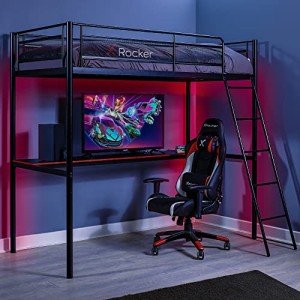Exploring Bunk Beds: A Comprehensive Guide
Bunk beds have actually long been a staple in kids's bed rooms, dormitories, and even homes with limited space. Not just do they offer a practical sleeping service, but they likewise create an enjoyable and creative environment for children and a great space-saver for adults and families. This article will explore everything you need to learn about bunk beds, from types and products to security suggestions and purchasing recommendations.
Tabulation
- Types of Bunk Beds
- Traditional Bunk Beds
- Loft Beds
- Triple Bunk Beds
- L-Shaped Bunk Beds
- Material Options
- Wood
- Metal
- Safety Considerations
- Buying Guide
- Frequently asked questions
Types of Bunk Beds
Bunk beds come in different designs to suit various requirements and choices. Here's a breakdown of the most common types:
Conventional Bunk Beds
Traditional bunks usually include two beds stacked vertically on top of one another. These beds are ideal for siblings sharing a room or for making the most of sleeping space in visitor spaces.
Loft Beds
Loft beds stand similarly to conventional bunk beds however do not have a lower sleeping location. Instead, they typically incorporate a desk or seating area beneath, making them a great option for little rooms requiring multifunctionality.
Triple Bunk Beds
Triple bunk beds are created for 3 occupants, with beds stacked in a three-tier setup. These are less typical but can be an enjoyable solution for large families or slumber parties.
L-Shaped Bunk Beds
With one bed placed horizontally and the other vertically, L-shaped bunk beds are frequently equipped with additional functions such as desks or storage drawers and can complement corner spaces in a space.
Comparison of Bunk Bed Types
| Bed Type | Suitable Use | Description |
|---|---|---|
| Conventional | Shared bed rooms or guest rooms | 2 beds stacked vertically |
| Loft | Small spaces needing multi-purpose space | Upper bed with open space underneath |
| Triple | Large households or sleepovers | 3 beds stacked vertically |
| L-Shaped | Corner or flexible areas | A mix of vertical and horizontal beds |
Material Options
Bunk beds are manufactured from numerous materials, with wood and metal being the most common. Each material has its pros and cons.
Wood
- Sturdiness: Generally robust and can stand up to years of usage.
- Aesthetic Appeal: Offers a classic appearance that can blend with numerous decors.
- Weight Capacity: Typically tougher; can support much heavier weights.
- Drawbacks: May be more expensive than metal choices and can be prone to scratches.
Metal
- Toughness: Generally light-weight and easy to move however still strong.
- Modern Design: Often comes in streamlined styles, making it appealing for modern spaces.
- Cost-Effective: Usually less costly than wood options.
- Downsides: Can be cold to the touch in winter seasons and might not have the same visual appeal for some purchasers.
Safety Considerations
When it comes to bunk beds, safety can not be neglected. Here are crucial security pointers to remember:
- Guardrails: Ensure that the top bunk has guardrails on both sides to avoid falls.
- Tough Construction: Check for a solid develop and tough products to hold up against weight and motion.
- Weight Limit: Adhere to the producer's weight limitation for both the upper and lower bunks.
- Ladder Design: Choose bunks with a safe, easy-to-climb ladder and avoid any sharp edges or rungs.
- Age Restrictions: Most makers recommend that children under the age of six must not sleep in the upper bunk.
Buying Guide
When looking for bunk beds, think about the list below factors to discover the best suitable for your requirements:
- Space Availability: Measure the room size and ceiling height, guaranteeing there is sufficient space for the leading bunk.
- Bed Size: Decide between twin, complete, or larger sizes based upon your needs and the size of the room.
- Design Preference: Consider the general decoration of the bedroom to discover an appropriate style.
- Relieve of Setup: Look for a bunk bed that is uncomplicated to put together.
- Budget: Bunk beds are available in various rate ranges, so identify a budget before starting your search.
FAQs
1. What is the recommended age for children to sleep on the leading bunk?
Kids aged six and older are usually recommended to sleep on the leading bunk to decrease the threat of falls.
2. How can I make my bunk bed more secure?
To improve security, make sure guardrails are appropriately installed and check that the bed is put on a flat surface area. In addition, motivate children to use the ladder thoroughly.
3. Can I transform a bunk bed into 2 separate beds?
Numerous bunk beds are designed to be convertible. Examine the manufacturer's specifications for convertibility functions.
4. What Bunk Beds johnstezzi.top are readily available for bunk beds?
Typical devices consist of beddings, storage drawers, staircases instead of ladders, and tented canopies for a fun visual appeal.
5. How do I preserve my bunk bed?
Routine look for loose screws or structural integrity can assist ensure safety. Dust the bed regularly and clean spills immediately to keep the products in good condition.
Bunk beds are flexible and a space-efficient service for various living circumstances, from children's rooms to guest accommodations. With many styles and products offered, possible buyers have a wealth of alternatives to consider, ensuring a mix of practicality and looks. By focusing on safety and following the pointers described in this guide, people can discover the ideal bunk bed that fits their space and way of life, all while developing an enjoyable sleeping environment.

